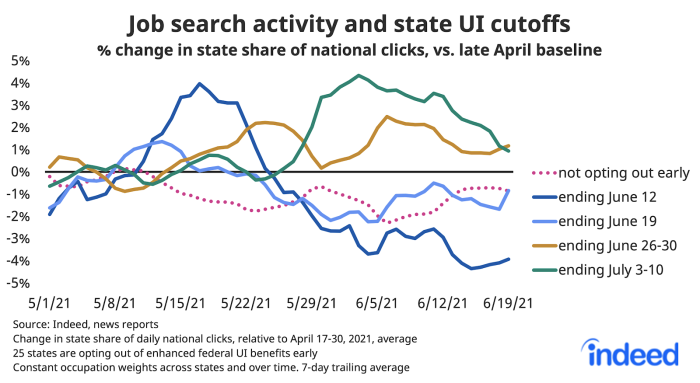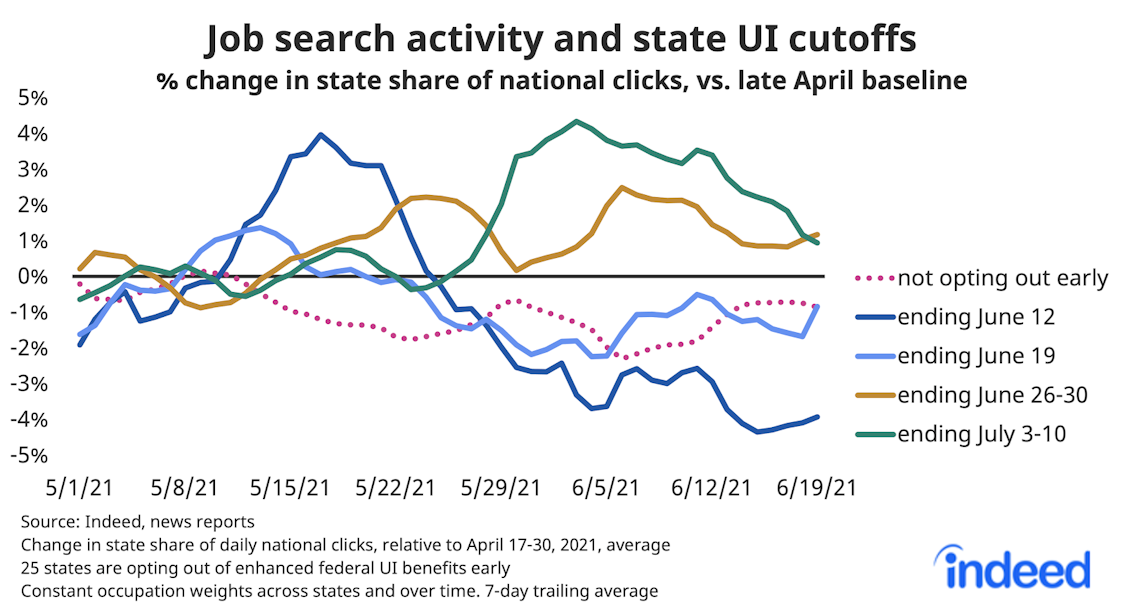Job searches are lower in states that were first to cut off federal pandemic-related unemployment benefits, compared to states that have continued to participate in those federal programs, according to analysis by Jed Kolko, the chief economist for the online jobs site Indeed.
Governor Kim Reynolds announced on May 11 that Iowans would cease to be able to collect the pandemic-related unemployment, effective June 12, putting Iowa among the first four states to end their participation in the federal programs. Tens of thousands of jobless Iowans were receiving a total of more than $30 million a week through the three discontinued programs. Iowa business groups and Republican politicians applauded the move, saying the extra unemployment benefits were holding back the economy by keeping people out of the workforce.
Kolko regularly tracks online job searches and found last month that “job search activity on Indeed increased, relative to the national trend, in states that announced they would end federal UI benefits prematurely.” However, “This increase was temporary, vanishing by the eighth day after the announcement. In the second week after the announcement, the state’s share of national clicks was no higher than it was during the late-April baseline.”
Kolko wrote on June 22 (emphasis added),
Search activity is up in some states that are opting out early of federal unemployment insurance benefits and down in others. Four states ended enhanced federal UI benefits on June 12, and eight more states ended them on June 19, months ahead of the official expiration on September 6. The share of national job search activity in these states, measured by clicks on job postings, is below the late April baseline. […]
It is unclear why search activity is below the baseline in states where federal UI benefits have ended. If overly generous federal UI benefits were holding back job seekers, then we would expect search activity to increase, relative to the national trend, in states where those benefits have ended.
Kolko gave Bleeding Heartland permission to publish this graphic from his latest post. The lowest number of job searches were measured in the four states that cut off the federal benefits on June 12.
Kolko observed in his May 27 post,
These federal UI benefits have been criticized for holding back hiring and contributing to a tighter labor market than would be typical after a sharp recession. However, the disincentive effect of these benefits is very hard to measure since they coincide with numerous other factors potentially affecting labor supply, like health risks, caregiving challenges, and eagerness to enjoy a vaccinated, reopened summer. Research on UI effects last summer found modest or minimal effects on labor supply, but the world is very different this summer. Now, economists are uncertain.
Iowa reporters have profiled people who are out of the workforce due to limited access to child care or transportation, or physical and health issues that keep them from taking jobs available in their community. Laura Crossett wrote here about her experience as a parent of a child with significant mental health challenges.
Speaking to Yahoo Money reporter Denitsa Tsekova on June 22, Kolko speculated,
“There are other factors that are probably holding people back from searching like continued concern about the virus,” Kolko said. “Some people might be waiting until later in the summer when schools are closer to opening and when people get a chance to take some time off.”
Iowa State University economist Dave Swenson has observed that Iowa’s labor force is still down by an estimated 80,450 compared to the pre-pandemic baseline.
Swenson tweeted on June 23,
The federal pandemic-related benefits are set to end nationwide on September 6, so economists will have many more opportunities to compare job searches and employment growth in states that opted out versus those that continued to let their eligible residents collect hundreds of dollars a week in federal benefits.


